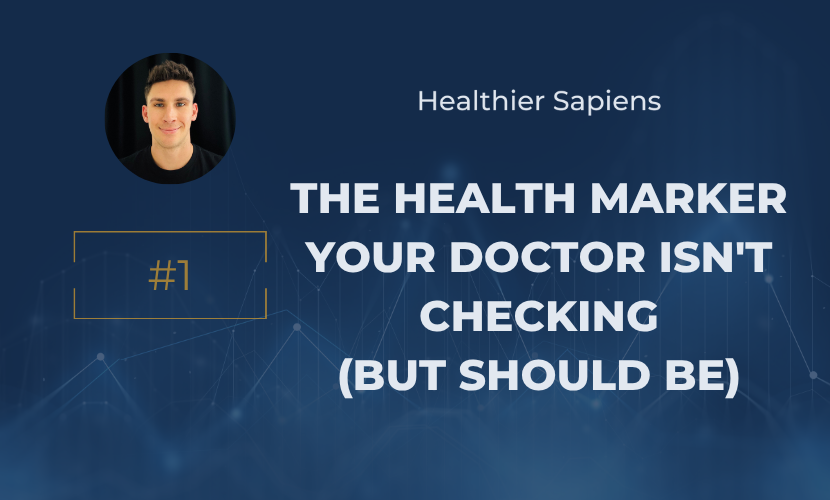The Health Marker Your Doctor Isn't Checking
Tomas Mitkus
10/17/20254 min read


Joe came to me last January, weighing in at 108 kg.
He was hitting the gym three to four days a week. Eating "healthy." Doing everything right according to conventional wisdom.
But his weight wouldn't budge. His energy was shot by 4 pm. And his latest blood work was concerning.
Joe's problem wasn't laziness or lack of discipline.
It was metabolic dysfunction. And he had no idea.
Six months later, Joe's down 23kg. More importantly, he's kept them off. His energy is stable all day. And his blood markers? Completely transformed.
Here's what changed: We stopped treating symptoms and started addressing the root cause.
Let me explain.
💡 This Week's Insight
Metabolic health is the foundation everything else sits on.
And most people walking around right now, including high-performing individuals like you, have terrible metabolic health without knowing it.
Here's what metabolic health actually means: It's your body's ability to efficiently convert food into energy and maintain stable blood sugar, healthy blood pressure, and optimal cholesterol levels.
When your metabolism works properly, you burn fat for fuel.
You have steady energy.
Your brain functions clearly.
Your waistline shrinks naturally.
When it doesn't? You're constantly hungry.
You store fat around your middle.
You crash in the afternoon.
And you're on a fast track to type 2 diabetes, heart disease, and cognitive decline.
The brutal truth: Research shows that only 12% of Americans have optimal metabolic health. Studies indicate that fewer than one in eight US adults maintains healthy metabolic function across key markers.
In the UK, we're not much better off.
Most concerning?
You can look thin and still be metabolically unhealthy.
Weight is just one marker.
The real damage is happening beneath the surface, in your blood vessels, your liver, your pancreas.
Joe looked fine to everyone else. But his bloodwork told a different story. His HbA1c was creeping toward prediabetic range. His triglycerides were elevated. His waist circumference had silently expanded beyond healthy limits.
None of this was on his radar until we measured it.
Here's what most people don't realise: metabolic dysfunction is reversible.
Completely.
But first, you need to know where you stand.
📈 Metrics Explained
You can't manage what you don't measure.
These four markers tell you everything about your metabolic health. Get them checked, know your numbers, and understand what they mean.
HbA1c (Glycated Haemoglobin)
This measures your average blood sugar over the past 2-3 months. It's the gold standard for assessing glucose control.
Healthy range: Below 42 mmol/mol (6.0%) Prediabetes: 42-47 mmol/mol (6.0-6.4%) Type 2 diabetes: 48 mmol/mol (6.5%) or above
If you're above 42 or creeping close to it, your body is struggling to manage blood sugar. That's metabolic dysfunction in real-time.
Lipid Panel
Three numbers that reveal how your body processes fats:
Triglycerides (should be below 1.7 mmol/L): High triglycerides signal poor carbohydrate metabolism and insulin resistance.
HDL cholesterol (should be above 1.0 mmol/L for men, 1.2 mmol/L for women): This is your "good" cholesterol. Low HDL is a red flag.
LDL cholesterol (optimal below 3.0 mmol/L): Context matters here. Small, dense LDL particles are the problem, not necessarily the total number.
The ratio matters more than individual numbers. Elevated triglycerides combined with low HDL cholesterol strongly indicate metabolic dysfunction and insulin resistance.
Blood Pressure
Optimal: Below 120/80 mmHg
Elevated: 120-129/80 mmHg
High: 130/80 mmHg or above
High blood pressure is both a symptom and a consequence of metabolic dysfunction. It damages your arteries and increases heart disease risk.
Waist Circumference
The tape measure doesn't lie.
Men: Keep it below 94cm (37 inches)
Women: Keep it below 80cm (31.5 inches)
Anything above these thresholds indicates visceral fat accumulation, the dangerous fat around your organs that drives metabolic disease.
Joe's waist had crept to 102cm. He hadn't noticed because his suits still fit. But that measurement told me everything I needed to know about his insulin resistance.
⚡ Quick Win
Pull out your most recent blood test results.
Right now.
Check them against the ranges I just outlined. If you don't have recent results, book a full panel this week through your GP or a private lab.
Look specifically at:
Your HbA1c number
Your triglyceride-to-HDL ratio
Your blood pressure readings
Your waist measurement (grab a tape measure if you haven't checked recently)
Don't assume everything's fine because your doctor didn't call. "Normal" lab ranges are often too wide. You want optimal, not just "not diseased yet."
If even one marker is outside the healthy range, you've identified your starting point. That's not bad news, it's actionable intelligence.
Joe's initial HbA1c was 39 mmol/mol. Close to the prediabetic threshold but not quite there. Six months later: 31 mmol/mol. A significant improvement that moved him solidly into the healthy range.
That didn't happen by accident. It happened because we measured, monitored, and adjusted our approach based on the data.
🔗 Worth Your Time
Two resources that will completely change how you think about metabolic health:
Book: "Metabolical" by Dr. Robert Lustig
Lustig is a pediatric endocrinologist who explains exactly how ultra-processed foods hijack your metabolism. He breaks down the biochemistry without requiring a medical degree to understand it.
The key insight: metabolic dysfunction isn't about calories. It's about how different foods affect your hormones, particularly insulin. Research demonstrates that processed foods alter metabolic processes beyond their caloric content, affecting hormone signalling and cellular function.
This book will make you angry about what the food industry has done. And it'll arm you with the knowledge to fight back.
Podcast: Huberman Lab with Dr. Casey Means
Dr. Means is a Stanford-trained physician who left traditional medicine to focus on metabolic health optimisation.
This three-hour conversation covers everything: blood sugar regulation, hormone optimisation, and practical strategies for improving metabolic markers.
Start with this episode if you want the scientific foundation. Huberman asks the right questions, and Means delivers evidence-based answers without the usual health guru nonsense.

